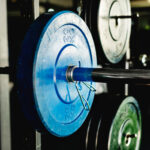Exercises You Should Be Doing: Crossover DB Step-Ups
In today’s installment of “Exercises You Should Be Doing,” we’re going to cover a simple- albeit effective exercise that I’ve been using quite a bit lately in many of the programs I’ve been writing.
To start, the conventional DB step-up is an excellent exercise for a few reasons.
As is the case for most trainees (not you, of course), our programs are woefully deficient in single leg work. For the record doing leg presses with one leg doesn’t count. Nice try, asshat. I don’t know why, but many fail to realize that single leg training is a completely different entity compared to bilateral training (think squats, deadlifts, etc). Simply put, once you stand on one leg, it changes the game entirely- particularly with regards to the hip stabilizers.
Coincidentally, the step-up is a fairly fool proof way to introduce someone to single leg training, without making them feel overwhelmed. Just about anyone can do them. And, depending on their fitness level, you can adjust the box height accordingly, which is important when trying to limit eccentric stress.
Eccentric stress= soreness. Call me crazy, but if I’m trying to give someone a training effect without making them too sore to walk the next day, the latter point is kind of a big deal. Make no mistake about it, however, you can definitely make the exercise harder or more challenging. Which is a perfect segue to this…….
What Is It: Crossover DB Step-Up
Who Did I Steal If From: Mike Robertson
What Does It Do: On top of what I mentioned above, this version of the step-up adds a little more hip internal/external rotation into the mix, which can be especially beneficial for those who suffer from patellofemoral (anterior) knee pain.
Key Coaching Cues: This is going to sound a bit goofy, but I like to tell people to pretend they’re wearing a pair of clown shoes while performing this exercise (ie: point toes up). In doing so, when they step onto the box, they’ll fire through the heel, which will automatically engage the hamstrings/glutes to a greater degree. Also, while doing this exercise, you’ll want to keep the chest “tall” and shoulder blades retracted. From there, you’ll simply step across with the right leg, step behind with the SAME leg to the opposite side. Repeat the same sequence on the other leg.
I like to keep the reps a little low(er) with this exercise- so try to shoot for 6-8 repetitions with each leg.



Comments for This Entry
Paul Bruce
Tony! I love seeing old articles of this thread - it's changed my programming a lot particularly with lower body training. I would have never thought about doing reverse or lateral lunges. But I can definitely see the benefit of mixing up directions of motion, especially for athletes. I was practicing these today, and realized how good of a glute stretch these are. I get a lot of pain around the piriformis, so it's nice this can act as a rehab AND strength exercise. Hopefully this isn't TOO off-topic: Do you ever program movements in the transverse plane for the lower body? I know single-leg work resists motion in the transverse plane, but have you found good reason to train moving in the sagittal plane? The only example I could think of is curtsy/drop lunges, which mirror cross-over step-ups quite well - but is that in the frontal plane?August 21, 2014 at 8:59 pm |